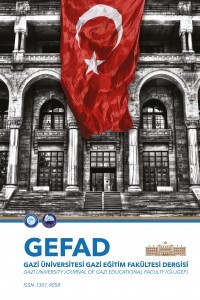Gençlerin Öfkelerini İfade Ettikleri Hedef Kişiler
Öfke ifadesi, cinsiyet, eğitim durumu
Targets Of the Young People in Expressing their Anger
Öfke ifadesi, cinsiyet, eğitim durumu,
___
- Averill, J.R. (1983). Studies on Anger and Aggression: Implications for Theories of Emotion. American Psychologist, November, 1145-1160.
- Brody, L.R., G.S. Lovas ve D.H. Hay (1995). Gender Differences in Anger and Fear as a Function of Situational Context. Sex Roles, 32, 47-78.
- Cüceloğlu, D. (1991). İnsan ve Davranışı: Psikolojinin Temel Kavramları, Remzi Kitabevi, İstanbul.
- Deffenbacher, J.L., R.S. Lynch, E.R. Oetting ve C.C. Kemper (1996). Anger Reduction in Early Adolescents. Journal of Counseling Psychology, 43(2): 149-157.
- Goleman, D. (2001). Duygusal Zeka. (Çev. Banu Seçkin Yüksel). Varlık/Bilim Yayınları, İstanbul.
- Kassinove, H. ve D.G. Sukhodlsky (1995). Anger Disorders: Basic Science and Practice Issues. Yayımlandığı Kitap H. Kassinove (Editör), Anger Disorders: Definition, Diagnosis and Treatment (1-26). Taylor and Francis, Philadelphia.
- Milovchevich, D., K. Howells, N. Drew ve A. Day (2001). Sex and Gender Role Differences in Anger: An Australian Community Study. Personality and Individual Differences, 31, 117-127.
- Norman, E.C. (1990). Role of Anger in Posttraumatic Stress. American Journal Psychiatry, 147: 1253.
- Retzinger, S. M. (1991).Violent Emotions: Shame and Rage in Marital Quarrels, Sage Publications, London.
- Stearns, F.R. (1972). Anger: Psychology, Physiology, Pathology. Illinois, USA: Charles C. Thomas Publisher. Springfield.
- Tavris, C. (1982).Anger: The Misunderstood Emotion. Simon and Schuster Press, NY, USA.
- Walters, R. P. (1983). Anger: What To Do About It. Inter-Varsity Press London.
- ISSN: 1301-9058
- Yayın Aralığı: Yılda 3 Sayı
- Başlangıç: 1985
- Yayıncı: Gazi Üniversitesi
Sümmani EKİCİ, Tekin ÇOLAKOĞLU
Bakü Tiflis Ceyhan BTC Ham Petrol Boru Hattı ve Türkiye Jeopolitiğine Etkileri
5 ve 6 Yaş Grubunda Çocuğu Olan Ebeveynlerin Tutumlarının İncelenmesi
Arzu ÖZYÜREK, Fatma Tezel ŞAHİN
Lise 2. Sınıf Öğrencilerinin Kuvvet Konusundaki Kavram Yanılgıları
Lise Birinci Sınıf Öğrencilerinin Sınıf İçi Güven Düzeylerinin Belirlenmesi
Gençlerin Öfkelerini İfade Ettikleri Hedef Kişiler
Türkiye de Gençliğin Toplumsal Kimliği ve Popüler Tüketim Kültürü
